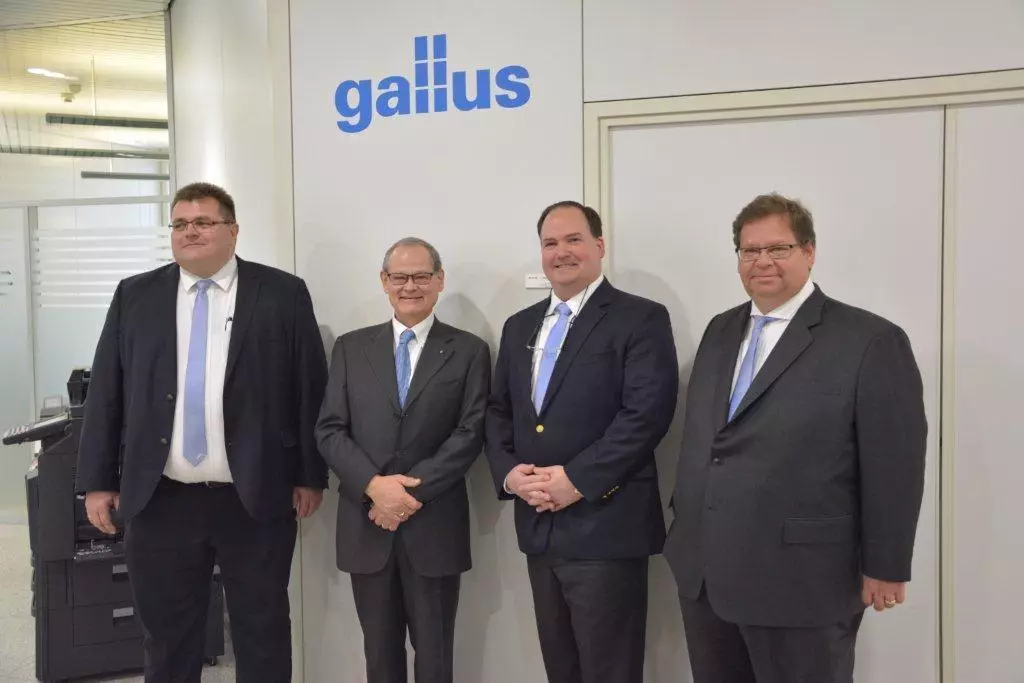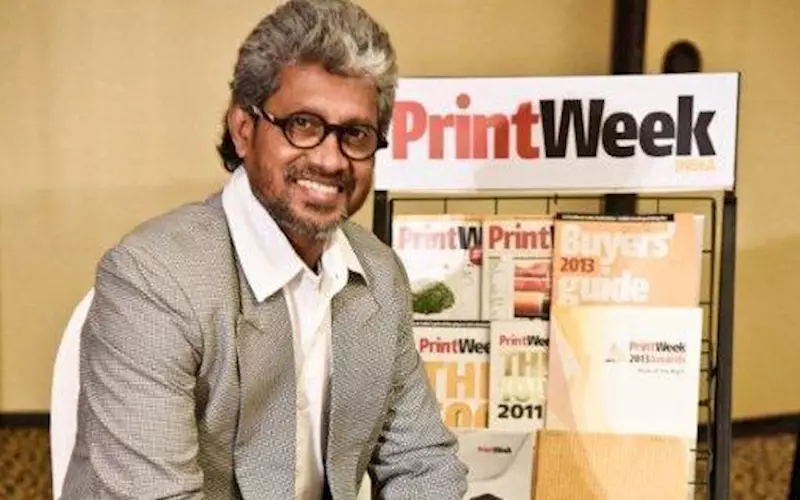The weather in St Gallan is most interesting during this time of the year. That is one part. The other is the natural beauty that is found around the place. And though the weather was a bit gloomy, the snow of the previous night, and few days before, made for a wonderful display.
I landed at the Zurich airport in the early hours, and a couple of hours later was en route to St Gallan. The reason was a pre-Drupa plant visit hosted by Heidelberg.
The 45 minutes train journey to St Gallan was filled with turn and climb up the hill station city.
The affable Ferdinand Ruesch, the owner of Gallus and a share holder in Heidelberg was ready to host the team of journalists from the Asia-Pacific region.

St Gallen has a history at every turn, says Ruesch proudly. It’s a rich city, whose textile industry was world renowned and from which business all the money came. The industry collapsed after the World War I, because the demand for luxury embroidery dropped significantly. The building around the city is a testimony of that richness. Some brands still use the St Gallen Swiss embroidery, at a price.
The other city’s landmark is the Convent of St Gall with its Boroque cathedral. St Gall (550 640AD), an Irishman was on a mission, and the legend has it, says Ruesch. “As St Gall was travelling in the woods, a bear emerged and charged at him. The holy man resisted, and so awed was the bear that it stopped the attack and went on his way. And to thank God, St Gall built the cathedral, which later added a convent school and the Abbey library,” says Ruesch. The library I am told has the biggest collection of books including a record number of hand-written Bibles.

After lunch, our next stop was at the Appenzeller cheese factory. While the process of making cheese from raw milk is long drawn and time-consuming, the making of the final product depends on a type of milk that is supplied. Here, most importantly, what kind of grass or food it is fed is most important, because it determines the quality of the milk. And this is monitored both by the cheese manufacturer as well as the cattle keeper.
………
The Gallus plant
Day two was the visit to the Gallus plant, a ten minutes drive from Einstein Hotel, which had nothing to do with the great scientist.
During the last Labelexpo Europe we saw an intriguing number of inkjet digital presses – 54, and also saw the advances made in production technologies.

And though the digital printed labels constitute about 7% of the label pie, worldwide we have seen 25-30% of all investment is made in the digital segment in the narrow web business, says Chistof Naier, head of sales, service and marketing at Gallus.
Gallus with Heidelberg entered the digital label segment with the launch of the DCS 340 label press. The hybrid press is a combination of three specialists, Gallus with flexo capabilities, Heidelberg brought in its digital print and workflow capabilities while Fujifilm designed the printhead technology.
“Gallus has print technologies that use a rotary screen, flexo and litho and it’s only a natural extension that Gallus brings to the market the marriage of flexo and digital together,” says Ruesch.
So what’s there in the Gallus DCS 340?
“It has the capability to print white, cyan, magenta yellow, black, as well as gamut expansion of green, orange of violate in digital format, not to forget upstream and downstream flexo capabilities,” says Michael Ring, head of digital sales at Gallus.
“And importantly, a unique application heads – printing and cold foiling prior to going into digital printing, overprinting on cold foil or flexo inks, not achievable on plain digital print engines. It allows a huge creative capability for designers in label application designs. And then the ability to add multiple flexo stations prior to die-cutting for potential brand identity colours as well,” he added.
Where will the success of Gallus DCS 340 come from?
It will come from the integration of the digital and flexo systems. “In terms of integration, you get the best of both world – flexo and digital in one convenient platform, one user interface taking care of the flexo as well as the digital module – the Prinect DFE for labels. The complexity of moving these two technologies together that has been attempted in the past is now simplified and the complexity is taken off the operator’s shoulder, and lets him do the work in hand, i.e., that is to print labels.”
The Gallus DCS 340 does not come in a fixed cost module or the click charge module. “The belief of taking all your variable cost and locking it down, taking away your advantage as a converter, does not make sense to us,” says Ring. “So, in terms of profitability, we have a truly flexible service cost model. The efficiency gains that a print converter shops make stays into the labelers pocket.”
So, it does not matter whether you are using three colour or eight, the cost of the label remains the same. Ring says, “We can claim to be the lowest.”
The other advantage with the flexo digital combination is the elimination of secondary process either for lamination, extra embossing or die-cutting. “In a digital standalone device, the majority of the work must go through a secondary process, making it less efficient. But with the Gallus DCS 340 the operations are done in one-pass, going from file to the finished label in one go at a speed of 50m/min regardless of the number of colours, resolution, size of the label or finishing requirements.”
The quality of dot?
With the Fujifilm head technology, Gallus claims it is able to control the dot down to a very small size of 2pl. “Actually, in a label about 90% of the image is produced with 2pl dot and the four and six pl dots are used to correct the image quality and solids.
“By being able to control the dot to such a small level, we are now able to meet offset standards. So we are now printing now printing up to 256 levels of gray, and printing at litho standards of 150lpi,” says Ring.
Gallus @ Heidelberg
With Gallus being a subsidiary of Heidelberg, the merging of sales and service was in the coming. So, from 1 April 2016, Gallus will operate from the Heidelberg India office located in Mumbai.
But the most important piece of news is the 100th installation of Gallus label presses in India. On 5 March, Gallus will be hosting a grand ceremony in Mumbai to celebrate the occasion.
The Gallus team l-r - Chistof Naier, Ferdinand Ruesch, Michael Ring and Rene Ludvigsen
 St Gallen has a history at every turn, says Ruesch proudly. It’s a rich city, whose textile industry was world renowned and from which business all the money came. The industry collapsed after the World War I, because the demand for luxury embroidery dropped significantly. The building around the city is a testimony of that richness. Some brands still use the St Gallen Swiss embroidery, at a price.
St Gallen has a history at every turn, says Ruesch proudly. It’s a rich city, whose textile industry was world renowned and from which business all the money came. The industry collapsed after the World War I, because the demand for luxury embroidery dropped significantly. The building around the city is a testimony of that richness. Some brands still use the St Gallen Swiss embroidery, at a price. After lunch, our next stop was at the Appenzeller cheese factory. While the process of making cheese from raw milk is long drawn and time-consuming, the making of the final product depends on a type of milk that is supplied. Here, most importantly, what kind of grass or food it is fed is most important, because it determines the quality of the milk. And this is monitored both by the cheese manufacturer as well as the cattle keeper.
After lunch, our next stop was at the Appenzeller cheese factory. While the process of making cheese from raw milk is long drawn and time-consuming, the making of the final product depends on a type of milk that is supplied. Here, most importantly, what kind of grass or food it is fed is most important, because it determines the quality of the milk. And this is monitored both by the cheese manufacturer as well as the cattle keeper. And though the digital printed labels constitute about 7% of the label pie, worldwide we have seen 25-30% of all investment is made in the digital segment in the narrow web business, says Chistof Naier, head of sales, service and marketing at Gallus.
And though the digital printed labels constitute about 7% of the label pie, worldwide we have seen 25-30% of all investment is made in the digital segment in the narrow web business, says Chistof Naier, head of sales, service and marketing at Gallus.













 See All
See All